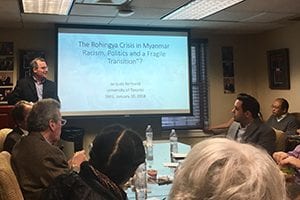More than 650,000 Rohingya people have fled the Rakhine State of Myanmar across the border to Bangladesh since a security crackdown began in August 2017. U.S. Secretary of State Rex Tillerson referred to the actions of the Myanmar armed forces as ethnic cleansing. This is the fourth wave of forced migration of the Rohingya population since the country began its democratization process in 2011. Dr. Jacques Bertrand, professor of political science at the University of Toronto, discussed the roots of this crisis and what might happen next at the SMU Tower Center Jan. 10.
Roots of Racism
To understand the resentment and hatred the Burmese feel toward the Rohingya, Bertrand argues we first need to understand colonial Burma. The British Empire began to colonize Burma in 1824.

the SMU Tower Center Jan. 10.
The Rakhine state was the first land to be annexed into the empire, and therefore experienced the highest levels of immigration of people from British India. These Indians became landowners and then continued to hire more Indians to work their land. The Burmese responded to the influx of Indian immigrants with a growing sense of nationalism and xenophobic sentiments.
Burma gained independence from the United Kingdom in 1948, and according to Bertrand, it was during this period that the Muslim Indian population in the Rakhine State identified themselves as Rohingya. The Rohingya enjoyed credibility in the democracy of the 1950s, but lost all their rights under the military regime of Ne Win in 1962. Ne Win attempted to remove all Indians from Burma in 1963-1964, claiming that they were foreigners and remnants of colonial rule. The Rohingya were then excluded from citizenship with the adoption of the 1982 citizenship law. By this law, residents had to prove they were living in Burma before colonial rule (1824) to gain citizenship. The law only recognized 135 ethnicities as national races, excluding several other minority groups from citizenship as well.
The first of the modern raids against the Rohingya was from 1991-1992, during which 200,000 Rohingya fled to Bangladesh. However, as stated earlier, there have been several waves of the Rohingya fleeing Myanmar since the democratization process began in 2011.
Understanding the Crisis
Bertrand laid out four key aspects that he felt are essential to understanding the Rohingya crisis.
1. Deep Historical Racism. The racism dates back to colonial Burma, as described above. Also important to note, Bertrand says, is the involvement of Buddhist monks with spreading these sentiments. Monks, who are highly revered in Myanmar, have demonstrated against the Rohingya and Muslims in general, helping to fuel the already-present xenophobic feelings in the Burmese people.
2. Myanmar and the Politics of Ethnicity. Sixty-five percent of the population are Burmese. To be Burmese means to be both Burman and Buddhist. Bertrand argues that the country’s biggest problem, at every step of its development, is its exclusion of the numerous ethnic minority groups the country is home to, and has been home to for centuries. They need to find a constitutional settlement with the groups, he argues. The 2008 Constitution maintains the 135 national races established in the 1982 citizenship law. Without a broader, more inclusive, sense of nationalism, the country will remain in conflict with the unrepresented groups.
3. Rakhine Nationalism. The Burmese government claims the Rohingya people are Bengali, not Rohingya. They entered Burma illegally under British rule. They can’t acknowledge Rohingya as an ethnicity because that would give them a legal status in the country and provide them with access to citizenship and other rights. Rakhine nationalism plays a role in the crisis because, even though the Rohingya were one third of the Rakhine population in 2015, the nationalist movement within the state continues to gain force and push the Rohingya further north. This has forced them away from the coast, and as a result has taken away fishing, which had become the group’s main mean of survival.
4. Aung San Suu Kyi and the armed forces. Aung San Suu Kyi, winner of a Nobel Peace Prize and leader of Myanmar’s National League for Democracy, was given the title State Counsellor in 2016. Although the position gave her control over the president’s office and several departments including the foreign ministry, she still has limited control of the military, which is accused of carrying out the ethnic cleansing. Aung San Suu Kyi has been criticized for not pushing back against the armed forces enough in the wake of the crisis. However, Bertrand pointed out that she has a tight rope to walk between pushing for promised democratic reforms, and not pushing too hard, causing the military to take back full control of the country.
What could happen?
Bertrand ended his talk with two possible resolutions to the crisis, and the challenges that go along with both.
Repatriation. In the past, repatriation of the Rohingya back to Myanmar has resulted in returning to even fewer rights. In this case, the majority of the Rohingya villages have been burned down. They will likely return to no citizenship, will lose their property, will not be able to vote, and will have to withstand continued racism.
Resettlement. There is a policy vacuum in South East Asia, Bertrand said, because few countries have signed the Refugee Convention. This means there’s no regional framework for refugees, and that the Rohingya would not get any rights that come with a refugee status. Instead, they will continue to be viewed as illegal immigrants. As far as resettlement outside of Asia, Bertrand said that with the refugee crisis of the last few years it is hard to imagine Europe would be welcoming. And, with the immigration crackdown in the United States, he predicts very few will be able to resettle there either.